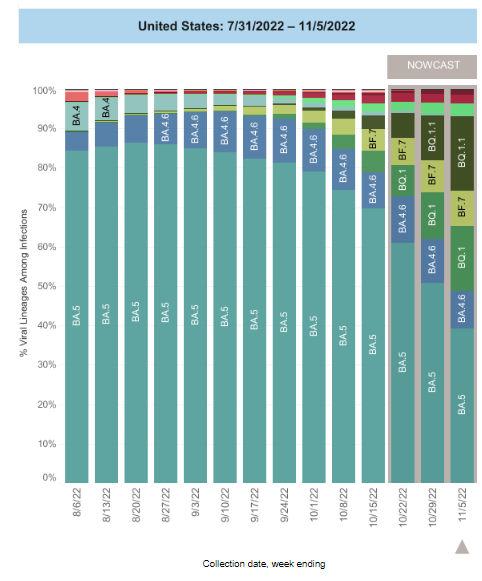The Weather: A slight increase from last week shows that 81.23% of the population is living with substantial or higher transmission.
As the winter holiday season approaches and more people travel and gather together, the rise in areas that already have substantial levels of transmission indicate a need to prevent further infections.

On Variants: BA.5 proportions have dropped to under 40% this week. BA.4.6 and BF.7 continue to be stable, at around 10% each. However, BQ.1 and BQ.1.1, the more immune-evasive variants, continue to rise by 8% this week—from 27% last week to 35% now.

There are regional differences in variant coverage across the US. In the West, BA.5 continues to be about half of cases, whereas it is about a quarter to a third of cases in the East.
BQ.1.1 is particularly high in NY, NJ, PR, and VI (Region 2) as well as in the Middle Rockies (Region 8), at 24% and 28%, respectively. BQ.1 is highest in the South Central area (Region 6) and again in Region 2, at 23% and 29%, respectively.

Wastewater Monitoring: National wastewater levels have shown a slight decline, including the Northeast, although that region still has the highest reported levels.

Hospitalizations: Nationally, hospitalizations remain mostly flat, as they have been in recent weeks. However, the Southeast, Midwest, Midcontinent, and Pacific Northwest are experiencing some increases.

Deaths: Between October 26 and November 1, 2,504 people died of COVID nationally. This is the 17th week in a row that at least 2,500 people have died from COVID.
With documented transmission increasing again, deaths remaining high, and new subvariants taking hold, the winter months are looking grim without proactive measures to combat the ongoing pandemic.
On Long COVID: A recent article reported on a study that found that COVID infection could increase vulnerability to developing severe neurological symptoms associated with Parkinson’s and Alzheimer’s.
Forecast: Global consensus from a multidisciplinary panel convened as part of a Delphi study highlighted key recommendations.
Some recommendations included the requirement of whole society engagement and a “vaccine-plus” approach, validating our call for layers of protection.
Researchers are working on nasal sprays that could prevent COVID infection and act as an additional layer of protection to vaccines and quality masking. However, funding and resources are lacking, highlighting the need to demand continued COVID research.
This report documents the consequences of decreased federal funding for COVID, especially with the upcoming planned expiration of the public health emergency declaration on January 11, 2023.
With the increased commercialization of essential public health resources, the country will face reduced supplies of tests and treatments, with the uninsured standing to lose the most. We must keep demanding that public health is a public good, not a private enterprise!
Take Action: Sign up to testify at the NYC hearing on COVID—scheduled for today, November 7th at 1PM—to call on NYC’s elected officials to invest more in COVID prevention efforts and Long COVID care.
The 1st annual People’s Public Health Conference was recently held online. Check out the conference booklet and list of presentations, including some from People’s CDC members, and join us next year!
Conferences like this are important alternatives to costly in-person conferences that often have few COVID protective measures, though advocacy can result in improved but still limited COVID measures, like partial masking.
Read & share this housing advocacy toolkit that outlines the connections between public health and housing, including the impact of COVID.
The National Institute of Health is seeking participants for Long COVID clinical studies to research possible prevention and treatments.
Notes: 1) The numbers in this report were current as of 11/4. The CDC updates data frequently as it receives refreshed information. Today’s numbers may be slightly different from the data here. 2) Check out the links throughout & see our website for more! https://bej.gbh.mybluehost.me.